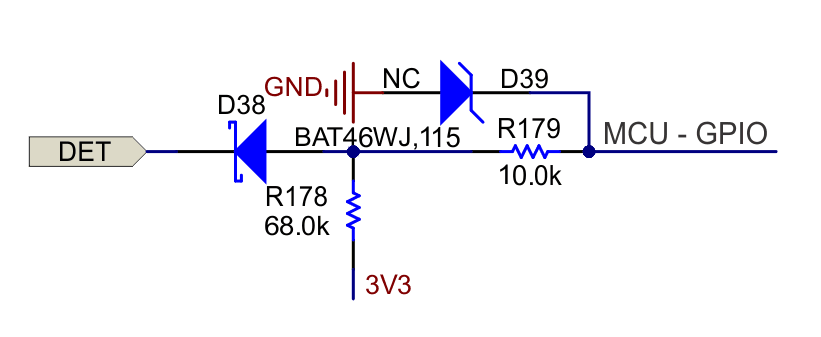SLUAAN9 February 2023 BQ769142 , BQ76942 , BQ76952 , BQ76972 , ISO1640 , LM5168
4 Current Consumption of Stacked Groups
The TIDA-010247 design guide describes the auxiliary power strategy of the stacked BQ769x2 design. In standby mode with the MOSFETs on (DET pulled low to ground), TIDA-010247 has about 300-μA total current consumption and about 10-μA current gaps between stacked groups. If the MOSFETs are off (DET floating), the total current consumption decreases to about 200 μA and the current gap increases to about 50 μA. TIDA-010247 utilizes the top BQ769x2 charge pump to switch the MOSFETs on and off; therefore, there is larger current consumption from the top BQ769x2 with the MOSFETs on causing larger total current consumption than the MOSFET off condition. In standby mode, the host MCU switches off ISO1640 power supply and disables the DC-DC LM5168P by pulling EN low to save power, and the 5-V and 3.3-V rails are provided by the bottom BQ769x2 regulator. There is about 50-μA total current including the MCU, transceiver, and other leakage current causing the current gaps since there is no further current consumption from the top BQ769x2, except the IC supply current. An external IO circuit is designed in TIDA-010247 to detect if the battery is attached with a load or charger. Choosing the appropriate pullup resister (R178) is helpful to shrink the current gaps with DET attached (which allows the MOSFETs to turn on). This is especially helpful for a specific working condition.
Figure 4-1 TIDA-010247 Auxiliary Power Strategy

Figure 4-2 DET Circuit to Detect Charger or Load in TIDA-010247
When a charging or discharging current wakes up the TIDA-010247, the DC-DC is enabled, taking over the 5-V and 3.3-V rail and does not cause an imbalanced current. The I2C isolator ISO1640 is still powered by the top and bottom BQ769x2 regulators separately to reduce the imbalanced current (see GUID-20221129-SR0T-NBVV-XLXR-4XHHLZ52HR4G.html#FIG_TG5_XXH_VVB, Communication With the Top and Bottom BQ769x2).
The supply current specifications of the ISO1640 device are listed in Table 4-1. The supply current gaps of the ISO1640 device contribute the most group imbalance current under normal working conditions.
| Parameter | Test Conditions | MIN | TYP | MAX | Unit | |
|---|---|---|---|---|---|---|
| ICC1 | Supply Current, Side 1 | VSDA1, VSCL1 = GND1, VSDA2, VSCL2 = GND2, R1 and R2 = Open, C1 and C2 = Open |
5.2 | 7.1 | mA | |
| VSDA1, VSCL1 = VCC1, VSDA2, VSCL2 = VCC2, R1 and R2 = Open, C1 and C2 = Open |
3 | 4 | mA | |||
| ICC2 | Supply Current, Side 2 | VSDA1, VSCL1 = GND1, VSDA2, VSCL2 = GND2, R1 and R2 = Open, C1 and C2 = Open |
4.9 | 6.7 | mA | |
| VSDA1, VSCL1 = VCC1, VSDA2, VSCL2 = VCC2, R1 and R2 = Open, C1 and C2 = Open |
2.8 | 3.5 | mA | |||
A good way to further decrease the current gaps is to add TI isolated power modules to power the secondary sides of ISO1640 and use the main 3.3-V rail to power the isolated power module and ISO1640 primary side. #FIG_WWN_KYH_VVB shows the block diagram.
Figure 4-3 Power ISO1640 With Isolated Power Module
Both sides of the ISO1640 device are powered by the main 3.3-V rail, since the main 3.3-V rail is designed to sink power from the total pack voltage, eliminating further current gaps between groups.
Since the BQ769x2 device also supports SPI communications with the host MCU, another solution is to replace I2C with SPI communication and use the TI ISOW7741 device. The ISOW7741 is a digital isolator integrated DC-DC converter. ISOW7741 achieves the isolation of SPI communication and integrates isolated DC-DC to power the secondary side. All power comes from the main 3.3-V rail which results in no imbalanced current.
Figure 4-4 Isolated SPI Communication With ISOW7741
The TIDA-010247 also reserves external pack balancing functions through REG2 of both the top and bottom BQ769x2. The host MCU can enable either BQ769x2 REG2 to start pack balancing, but needs to note the maximum balancing current must follow the BQ769x2 regulator current limitations.